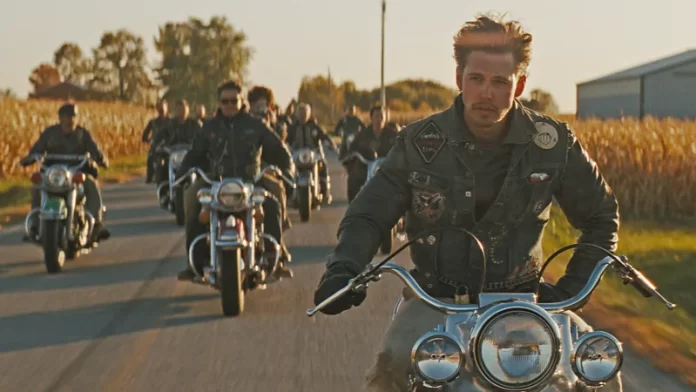The revving vibration of a chrome engine, the acidic smell of tarmac and motor oil, wind in the hair and two wheels on the road: few vehicles are as writ large on the subconscious of the cinema-going public as the motorcycle. Jeff Nichols’ new film The Bike Riders is loosely based on the early years of real-life biker gang the Chicago Outlaws, who are fictionalised onscreen as the Vandals, and mythologises them and their journey from innocence to experience in the advancing years of the 1960s. Revealing an arch awareness of the films of bikers past, Nichols borrows from a rich lexicon of cultural fascination with the mirage of the leather-jacketed rebel.
The Bikeriders is based on a landmark book of photojournalism from Danny Lyon, who as a young man in the early 1960s joined the motorcycle club to learn about and photograph the rough-and-ready outsiders who populated it. The film draws on many of the actual bikers who Lyon hung out with, including Austin Butler as Benny, the gang’s wildest and most charismatic member, with Jodie Comer as his girl Kathy and Tom Hardy as Johnny, the leader of the group. It’s Kathy, though, who narrates the story, and from whose point of view it is told: depicted onscreen speaking to an audio recorder in laundromats and living rooms, in real-life she also spoke to Lyon (Mike Faist, in the film) about her experience living with the bikers.
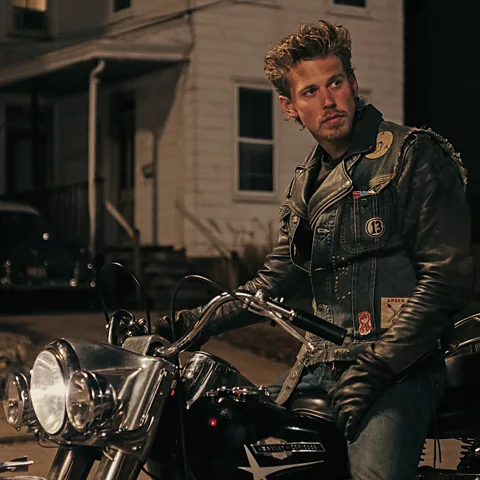
A symbol of rebellion
Since the rise of the US motorcycle gang movie in the 1950s – the ground zero of the biker film was The Wild One (1953), featuring a leather-clad young Marlon Brando – the biker movie has come to symbolise counterculture, rebellion, danger, and the freedom of the open road on our screens, to the point where it’s passed into stereotype. Growing popular concurrent with the actual rise of the motorcycle club in the US, the genre also waned after the real-life counterparts – which began as social hubs for hobbyist mechanics and racers – degenerated into organised crime.
Nichols, a filmmaker with his roots in US independent film and an interest in the nation’s cultural history, has long been in love with the subject matter. “I found Danny’s book when I was in my early 20s, and my oldest brother was reading it,” he tells the BBC. “I was immediately captivated by the photographs, and then I dug deeper, and the text in the book is just transcribed interviews of the bike riders and one of their wives, and you just get this complete picture of the subculture. It was like a breakdown of their psychology and their style.” It took some time for him to build a story from the disparate transcripts, however. “I knew I had the shape of something that had formed in the late 50s all the way to becoming a proper gang in the early 70s. But that’s not really a story. Then, I thought about the way the real Kathy spoke about Benny. It was hilarious and beautiful and self-deprecating and introspective. I thought: ‘What if there was this other character who ran the club that was equally in love with this young man?’ And that’s where the idea of this love triangle kind of came into play.”

Told in flashback using Kathy’s voiceover, the film luxuriates in the mythic and OTT elements of the iconography: the motorcycle boots, jackets, cigarettes, and rubber squeals that are familiar to any of us who have watched biker movies of the era. It spends time focusing on these details, giving a dreamy, even fetishistic quality to them on-screen; comparing it to a Levi’s ad would not be an insult, given its totemic and knowing tone. This is never better applied than in the depiction of Austin Butler’s Benny, whose piercing blue cowboy squint and monosyllabic mumble lend themselves to it perfectly. Nichols often recreated Danny Lyon’s original photographs down to the smallest detail, and he does this for our introduction to Benny, who is leaning down over a pool table in a jukebox joint when Kathy first sees him. Copycatting the 1965 photo Benny at the Stoplight, Nichols swoops in and dazzles the viewer.
As soon as I shook Austin’s hand, I was like: this is a movie star. At this point in my career, I’ve been around a lot of famous people, but he has the thing – Jeff Nichols
“The script started to circulate, and maybe it’s not shocking a lot of young actors in Hollywood really responded to it and wanted to be in a 1960s motorcycle film,” Nichols says of the casting. When he met Austin Butler, he says, “I had the same reaction that everyone has. As soon as I shook his hand, I was like: ‘This is a movie star, and it’s not just the looks. He has a presence.’ At this point in my career, I’ve been around a lot of famous people, but he has the thing. I was immediately engaged by him and I offered him the part on the spot. It was before Elvis had come out.”
Seemingly unaffected by physical pain and reckless to the point of total fatalism, Benny has no malice in him, only a kind of disinterest in anything but riding his pristine Harley and picking fights for the fun of it. We see a private, puckish grin on his face when he’s running traffic lights and evading police capture in a small Chicago enclave, revelling in his juvenile rebellion. He’s a a romanticised image of what the early bike-riding subculture was about, before it began to wither and grow nastier.
Nichols also cast Tom Hardy as Johnny, the older, wiser leader of the pack, who is shown watching Brando in The Wild One in the film itself. It reveals another layer of Nichols’ self-awareness: even the foundational biker gangs were influenced by film and television. “There was a real Johnny who did start this club, and he had a family[-style] photo album but for the club. And in the album was a clipping of a TV Guide with Marlon Brando on it. He thought he’d start his own little club. Little did he know he was about to start the Chicago Outlaws, which would become the second largest motorcycle gang in the world.”
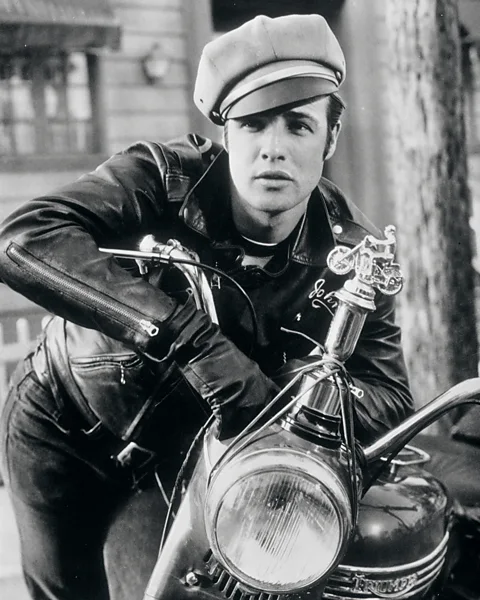
Beginning in the postwar period as social clubs, these outlaw groups (only known as such initially because they did not follow American Motorcyclist Association rules) transformed over the years. Many were joined by veterans from World War Two as well as the wars in Korea and later Vietnam, longing for an adrenaline fix and the company of groups of men after their time in the military. But bohemianism had an effect, and the striking, unusual look of the bikers as they rode into small conservative towns would cause much concern. As one biker told Danny Lyon – the line is repeated in the film – “People think bikes lead to something negative. But everybody needs somebody to pick on.”
How the bikers turned criminal
Roger Corman, the recently deceased legendary distributor and exploitation film producer, was one of the key figures in the rise of the biker B-movie. Responsible for the early careers of Martin Scorsese, Jack Nicholson, and many others, he would seize on the box-office phenomenon of Easy Rider (1969) to make a whole host of flicks about countercultural – or even frenzied criminal – motorcycle gangs. From Motorpsycho (1965) to Hells Angels on Wheels (1967), the motorcycle was central to an image of increasingly violent and drug-oriented organised crime on wheels.
Equally, in The Bikeriders, as time goes on we begin to see the rift between the “pot smokers” and the “beer drinkers”, who were the earlier members and not drugtakers – a real discord occurred in the latter part of the 60s and into the 70s, largely due to returning Vietnam veterans swelling the ranks of motorcycle clubs, whose drug use often went beyond marijuana. Heavier drugs pervaded the scene, changing the tone of hangouts and parties, such that fistfights turned to gun fights.
Women and men alike seem to flock to the imagery of the biker. In the 60s, The Shangri-Las sighed, pined, and swooned over dead biker boyfriends in their haunting music
“These new guys… none of ’em listen,” Hardy mutters late in the film, overwhelmed by the lack of respect for what he has built. He is losing control of what he started, and the idea of a fair fight with fists or even flick-knives has been displaced by guns and murder. As Nichols says: “At its core, the thing that drove these guys is a sense of belonging, a sense of finding an identity. It’s not uniquely male; I think we’re all looking for some purpose in our lives, and an identity stands in for purpose. So a lot of people try to find their identities in a group. It’s classic tribalism. The more unique the group is that you find, the more unique your identity is. And so it can be very powerful. That could be a really positive thing, but it can also be a really negative thing. Oddly, The Bikeriders represents both. At the beginning, there are positive things about these guys getting together. But in the end, that’s not true.”
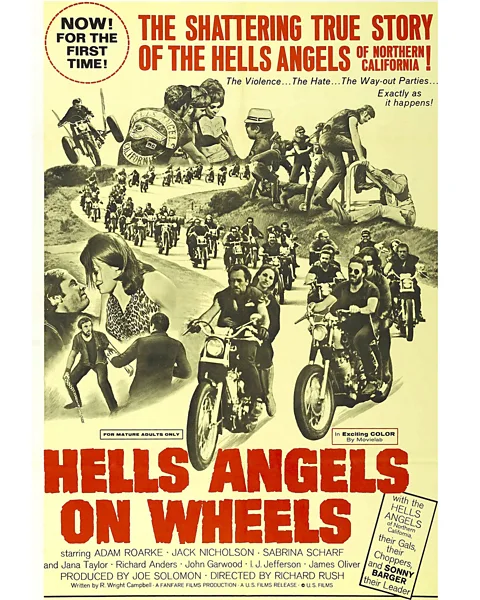
The Bikeriders depicts the startling violence of this world with organic realism – particularly in a sequence where Kathy and the group attend a house party that spirals dangerously out of control and nearly concludes in sexual assault. But it also combines the mythic Americana of films like Francis Ford Coppola’s 1983 coming-of-age drama Rumble Fish (in which another tousle-haired pretty boy in a leather jacket – a young Mickey Rourke – plays a character known only as “Motorcycle Boy”) and Kathryn Bigelow’s The Loveless, a sexily posturing and knowing biker flick from 1981. Just as the ugliness, substance abuse, and increasing danger of this world are shown, so too is the excitement and appeal.
The Bikeriders is about examining masculinity for both its truths and its lies, because there are a lot of both of those things – Jeff Nichols
Women and men alike seem to flock to the imagery of the biker. In the 60s, The Shangri-Las sighed, pined, and swooned over dead biker boyfriends in their haunting music – their 1964 hit Leader of the Pack, as Nichols points out, actually has motor engines revving in the background, and the song of theirs he uses as a motif throughout The Bikeriders – 1965’s Out in the Street – echoes across the film. With its lyrics of attraction/repulsion (“He don’t comb his hair/like he did before/And he don’t wear those dirty old black boots no more/But he’s not the same”), it reflects what’s felt by Kathy, too.
“There’s this tension in masculinity, because we know there’s so much of it that’s just silly and ridiculous. The idea that these guys can’t express themselves, they’re creating all these rules for themselves,” Nichols points out. “We see as a society that masculinity doesn’t have to be cornered in this way and she sees the absurdity of it, but she’s also drawn to it. And that’s real. It’s attractive. To not admit that is not being true to ourselves, because she is in love. Not just with Benny, but with the idea of riding on motorcycles and the idea of this culture. She’s pulled between these two things, and so she’s not just an observer. She’s actually a participant in this tension.”
Their homoerotic draw
Men, too, have long found homoerotic appeal in the subculture, from Tom of Finland drawings to films like Kenneth Anger’s Scorpio Rising (1963) or William Friedkin’s Cruising (1980). There seems to be a nod toward this in Nichols’ reference to a so-called “love triangle” in the film, and the mounting tension between Kathy and Johnny for Benny’s attention. In one scene at a campfire hangout, Johnny attempts to pass on leadership of the Vandals to Benny, who refuses – albeit softly. The two speak with a quiet intimacy, faces close, softly burnished by the fire beyond; there’s a pregnant pause where it feels inevitable their lips will meet. They do not, but the moment is noted.
For men who felt like outsiders for their interests, their class, or perhaps even their sexuality, biker culture provided a brotherly niche and a place for friendship. But that male camaraderie might well lean into a different kind of tenderness for one another, Nichols implies. That this need for belonging might melt into violence is another possibility.
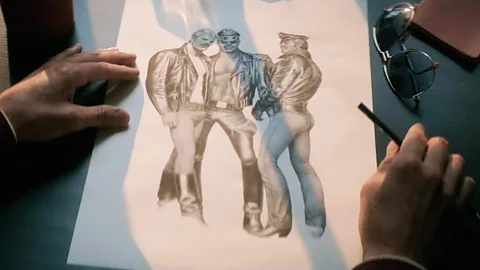
“It’s absolutely about masculinity,” Nichols says of his film. “But it’s also about examining masculinity for both its truths and its lies, because there are a lot of both of those things.” The Bikeriders – a heightened, retro world where men don’t cry unless they can’t ride their bikes, and wish for endless highways of freedom and possibility – might seem silly or overblown to some for these reasons. But therein lies the point: it shows the breakdown of that dream, revealing the golden age of biker culture for what it was: a brief and exciting moment, followed by nostalgia that’s so powerful it still intoxicates us.
The Bikeriders is out in US and UK cinemas on 21 June


